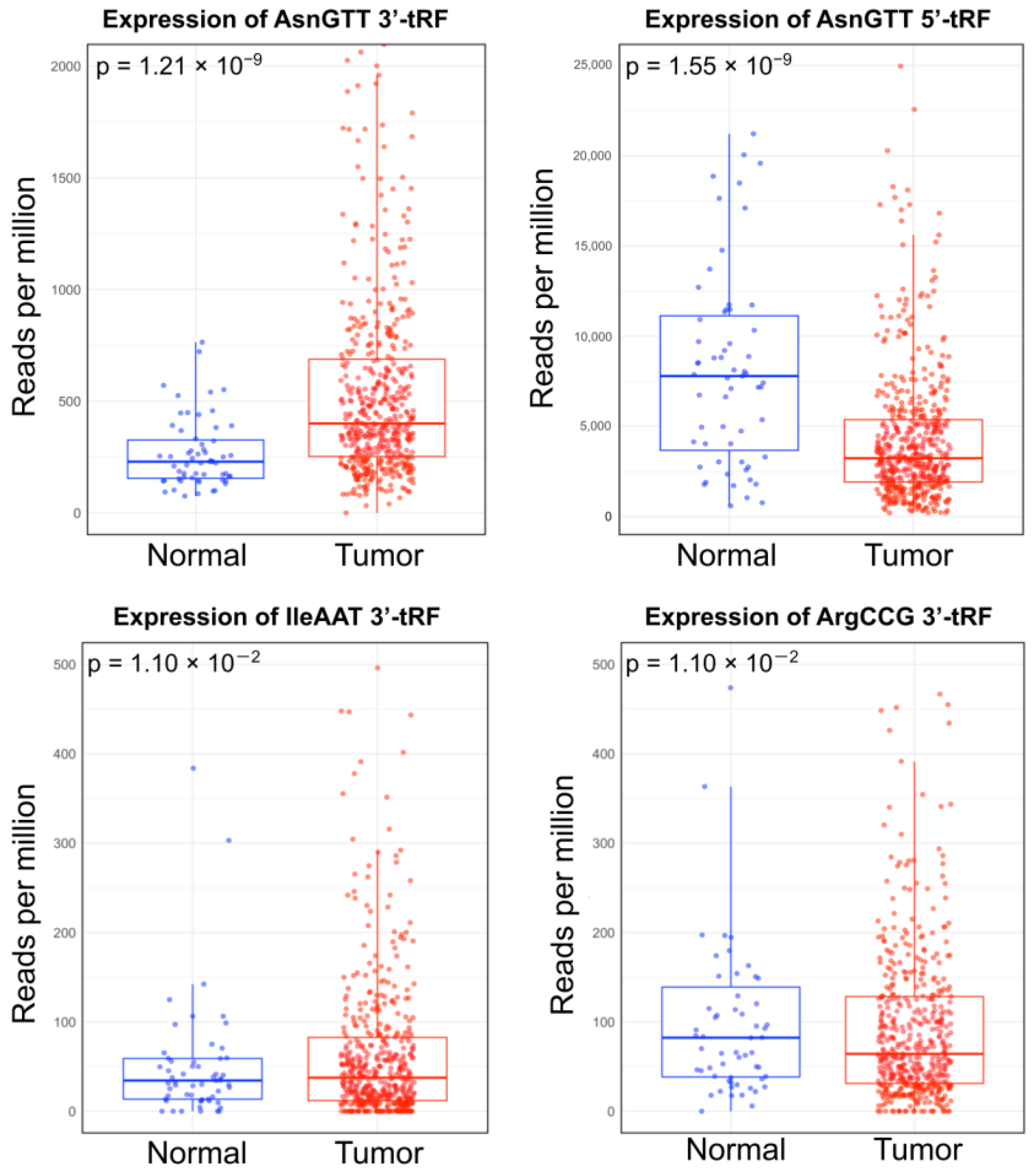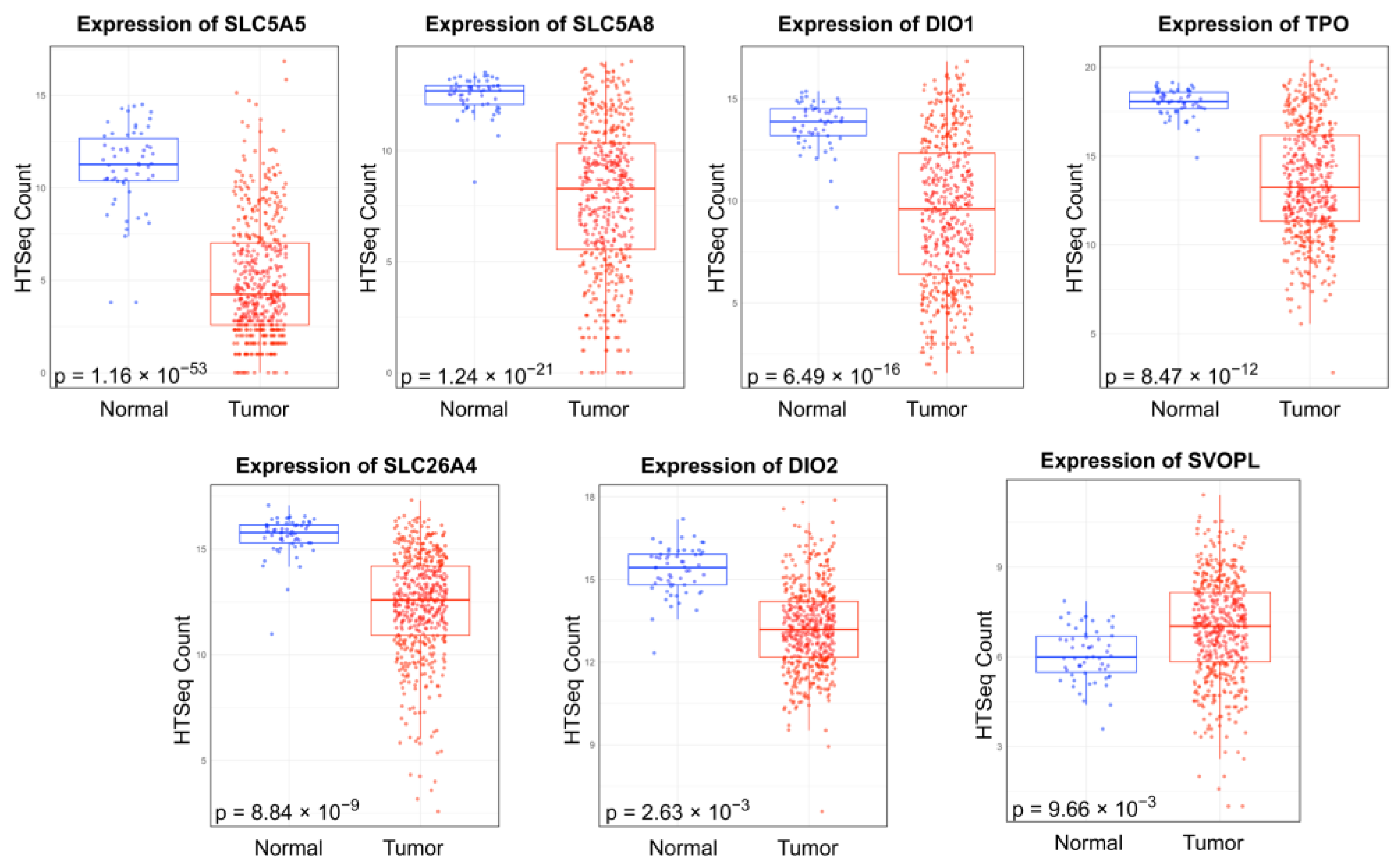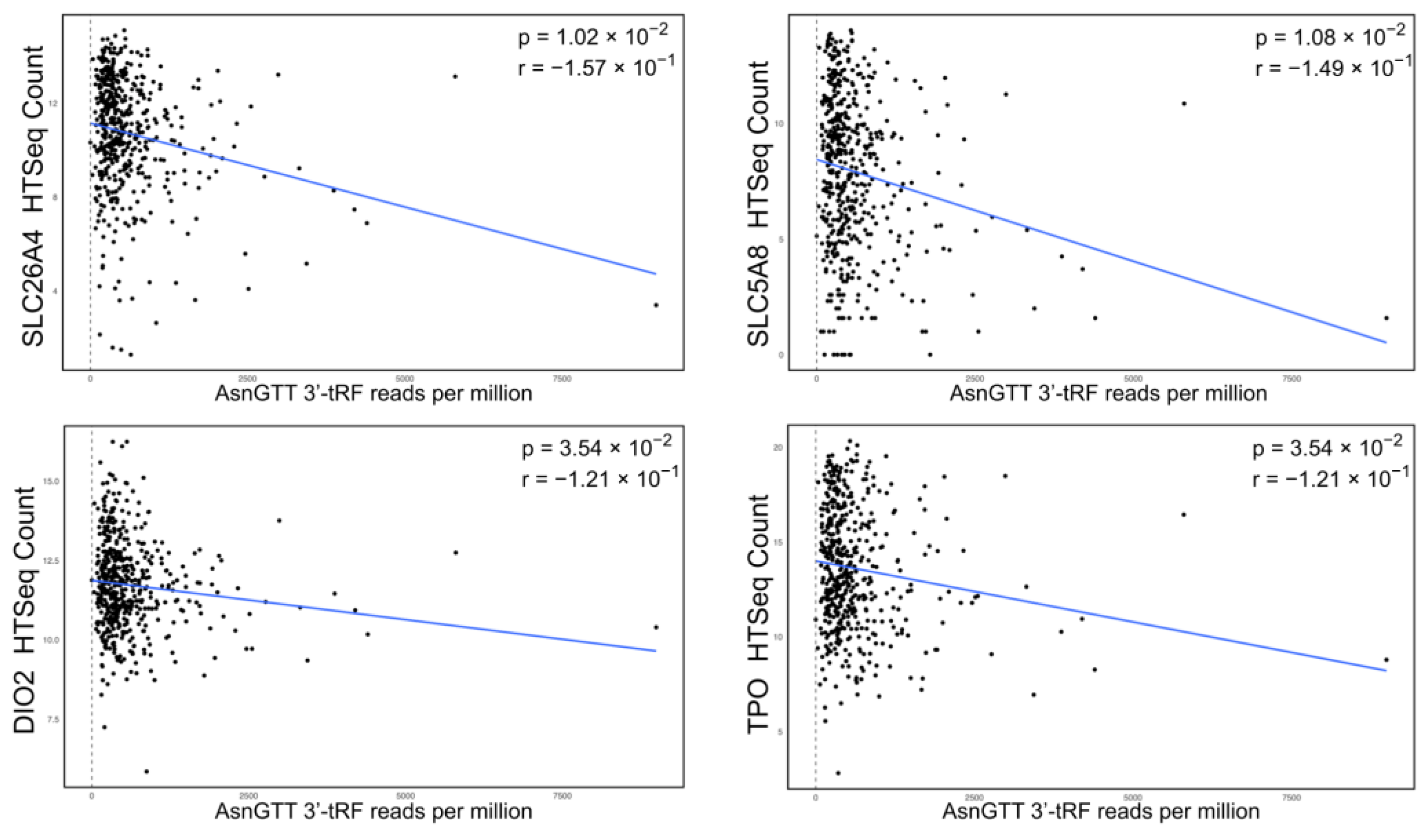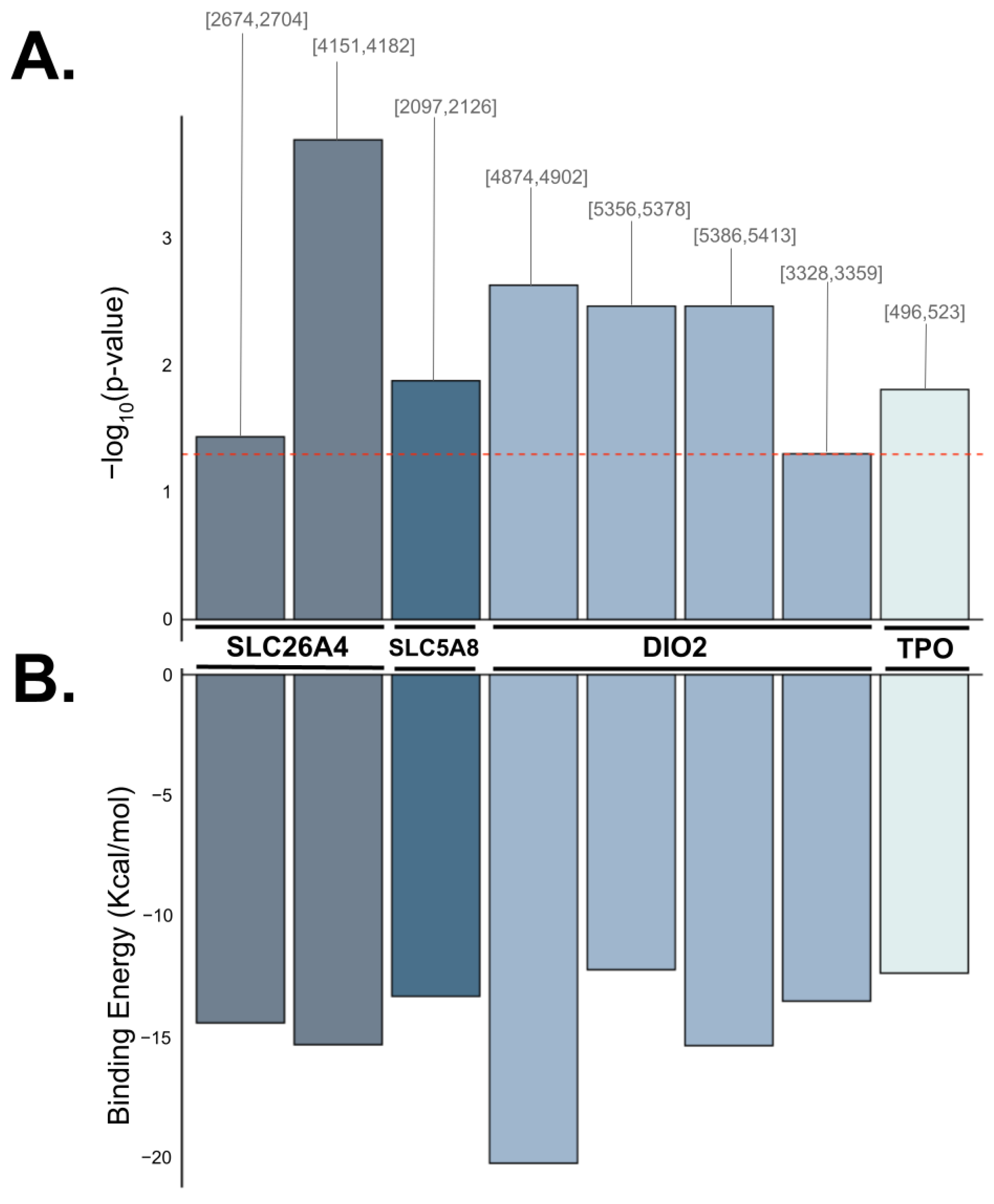Computational Analysis Suggests That AsnGTT 3′-tRNA-Derived Fragments Are Potential Biomarkers in Papillary Thyroid Carcinoma
Abstract
1. Introduction
2. Results
2.1. Differentially Expressed tRFs and PTC Driver Genes
2.2. Negative Correlation between the Expression of Dysregulated tRFs and Dysregulated Genes
2.3. Binding Affinity Analysis
3. Discussion
4. Materials and Methods
4.1. Data Acquisition
4.2. Differential Expression Analysis
4.3. Anticorrelation of tRF Expression and Gene Expression
4.4. Binding Affinity
4.5. Plots
4.6. Lead Contact
5. Conclusions
Author Contributions
Funding
Institutional Review Board Statement
Informed Consent Statement
Data Availability Statement
Conflicts of Interest
References
- Lim, H.; Devesa, S.S.; Sosa, J.A.; Check, D.; Kitahara, C.M. Trends in thyroid cancer incidence and mortality in the united states, 1974-2013. J. Am. Med. Assoc. 2017, 317, 1338–1348. [Google Scholar] [CrossRef] [PubMed]
- Sung, H.; Ferlay, J.; Siegel, R.L.; Laversanne, M.; Soerjomataram, I.; Jemal, A.; Bray, F. Global cancer statistics 2020: Globocan estimates of incidence and mortality worldwide for 36 cancers in 185 countries. CA Cancer J. Clin. 2021, 71, 209–249. [Google Scholar] [CrossRef] [PubMed]
- Pereira, M.M.; Williams, V.L.; Johnson, J.H.; Valderrabano, P. Thyroid cancer incidence trends in the united states: Association with changes in professional guideline recommendations. Thyroid® 2020, 30, 1132–1140. [Google Scholar] [CrossRef] [PubMed]
- Cabané, P.; Correa, C.; Bode, I.; Aguilar, R.; Elorza, A.A. Biomarkers in thyroid cancer: Emerging opportunities from non-coding rnas and mitochondrial space. Int. J. Mol. Sci. 2024, 25, 6719. [Google Scholar] [CrossRef] [PubMed]
- Wang, J.; Cheng, H.; Li, X.; Wang, J.; Cheng, H.; Li, X. Modified ti-rads coupled with brafv600e enhances diagnostic efficiency in papillary thyroid carcinoma: Prospective study. Int. J. Gen. Med. 2024, 17, 3015–3025. [Google Scholar] [CrossRef]
- Chen, Y.; Yin, M.; Zhang, Y.; Zhou, N.; Zhao, S.; Yin, H.; Shao, J.; Min, X.; Chen, B. Imprinted gene detection effectively improves the diagnostic accuracy for papillary thyroid carcinoma. BMC Cancer 2024, 24, 359. [Google Scholar] [CrossRef]
- Kumar, P.; Kuscu, C.; Dutta, A. Biogenesis and function of transfer rna-related fragments (tRFs). Trends Biochem. Sci. 2016, 41, 679–689. [Google Scholar] [CrossRef]
- Krishna, S.; Raghavan, S.; DasGupta, R.; Palakodeti, D. tRNA-derived fragments (tRFs): Establishing their turf in post-transcriptional gene regulation. Cell. Mol. Life Sci. 2021, 78, 2607–2619. [Google Scholar] [CrossRef]
- Kumar, P.; Anaya, J.; Mudunuri, S.B.; Dutta, A. Meta-analysis of tRNA derived RNA fragments reveals that they are evolutionarily conserved and associate with ago proteins to recognize specific RNA targets. BMC Biol. 2014, 12, 78. [Google Scholar] [CrossRef]
- Pekarsky, Y.; Balatti, V.; Croce, C.M. tRNA-derived fragments (tRFs) in cancer. J. Cell Commun. Signal. 2023, 17, 47–54. [Google Scholar] [CrossRef]
- Goodarzi, H.; Liu, X.; Nguyen, H.C.; Zhang, S.; Fish, L.; Tavazoie, S.F. Endogenous tRNA-derived fragments suppress breast cancer progression via ybx1 displacement. Cell 2015, 161, 790–802. [Google Scholar] [CrossRef] [PubMed]
- Yu, M.; Yi, J.; Qiu, Q.; Yao, D.; Li, J.; Yang, J.; Mi, C.; Zhou, L.; Lu, B.; Lu, W.; et al. Pan-cancer tRNA-derived fragment CAT1 coordinates RBPMS to stabilize NOTCH2 mRNA to promote tumorigenesis. Cell Rep. 2023, 42, 113408. [Google Scholar] [CrossRef] [PubMed]
- Tong, L.; Zhang, W.; Qu, B.; Zhang, F.; Wu, Z.; Shi, J.; Chen, X.; Song, Y.; Wang, Z. The tRNA-derived fragment-3017a promotes metastasis by inhibiting nell2 in human gastric cancer. Front. Oncol. 2020, 10, 570916. [Google Scholar] [CrossRef] [PubMed]
- Sui, S.; Wang, Z.; Cui, X.; Jin, L.; Zhu, C. The biological behavior of tRNA-derived fragment tRF-Leu-AAG in pancreatic cancer cells. Bioengineered 2022, 13, 10617–10628. [Google Scholar] [CrossRef] [PubMed]
- Wu, J.; Yang, J.; Cho, W.C.; Zheng, Y. Argonaute proteins: Structural features, functions and emerging roles. J. Adv. Res. 2020, 24, 317–324. [Google Scholar] [CrossRef]
- Kuscu, C.; Kumar, P.; Kiran, M.; Su, Z.; Malik, A.; Dutta, A. tRNA fragments (tRFs) guide ago to regulate gene expression post-transcriptionally in a dicer-independent manner. RNA 2018, 24, 1093–1105. [Google Scholar] [CrossRef]
- Choi, E.-J.; Ren, J.; Zhang, K.; Wu, W.; Lee, Y.S.; Lee, I.; Bao, X. The importance of ago 1 and 4 in post-transcriptional gene regulatory function of trf5-gluctc, an respiratory syncytial virus-induced tRNA -derived rna fragment. Int. J. Mol. Sci. 2020, 21, 8766. [Google Scholar] [CrossRef]
- Green, J.; Ansari, M.; Ball, H.; Haqqi, T. tRNA-derived fragments (trfs) regulate post-transcriptional gene expression via ago-dependent mechanism in il-1β stimulated chondrocytes. Osteoarthr. Cartil. 2020, 28, 1102–1110. [Google Scholar] [CrossRef]
- Zhang, Y.; Bi, Z.; Dong, X.; Yu, M.; Wang, K.; Song, X.; Xie, L.; Song, X. tRNA-derived fragments: Trf-gly-ccc-046, trf-tyr-gta-010 and trf-pro-tgg-001 as novel diagnostic biomarkers for breast cancer. Thorac. Cancer 2021, 12, 2314–2323. [Google Scholar] [CrossRef]
- You, J.; Yang, G.; Wu, Y.; Lu, X.; Huang, S.; Chen, Q.; Huang, C.; Chen, F.; Xu, X.; Chen, L. Plasma trf-1:29-pro-agg-1-m6 and trf-55:76-tyr-gta-1-m2 as novel diagnostic biomarkers for lung adenocarcinoma. Front. Oncol. 2022, 12, 991451. [Google Scholar] [CrossRef]
- Gu, X.; Ma, S.; Liang, B.; Ju, S. Serum hsa_tsr016141 as a kind of tRNA-derived fragments is a novel biomarker in gastric cancer. Front. Oncol. 2021, 11, 679366. [Google Scholar] [CrossRef] [PubMed]
- Ye, C.; Cheng, F.; Huang, L.; Wang, K.; Zhong, L.; Lu, Y.; Ouyang, M. New plasma diagnostic markers for colorectal cancer: Transporter fragments of glutamate tRNAorigin. J. Cancer 2024, 15, 1299–1313. [Google Scholar] [CrossRef] [PubMed]
- Sahlolbei, M.; Fattahi, F.; Vafaei, S.; Rajabzadeh, R.; Shiralipour, A.; Madjd, Z.; Kiani, J. Relationship between low expressions of tRNA-derived fragments with metastatic behavior of colorectal cancer. J. Gastrointest. Cancer 2022, 53, 862–869. [Google Scholar] [CrossRef]
- Gu, X.; Wang, L.; Coates, P.J.; Boldrup, L.; Fåhraeus, R.; Wilms, T.; Sgaramella, N.; Nylander, K. Transfer-RNA-derived fragments are potential prognostic factors in patients with squamous cell carcinoma of the head and neck. Genes 2020, 11, 1344. [Google Scholar] [CrossRef] [PubMed]
- Toden, S.; Goel, A. Non-coding RNAs as liquid biopsy biomarkers in cancer. Br. J. Cancer 2022, 126, 351–360. [Google Scholar] [CrossRef]
- Le, P.; Romano, G.; Nana-Sinkam, P.; Acunzo, M. Non-coding RNAs in cancer diagnosis and therapy: Focus on lung cancer. Cancers 2021, 13, 1372. [Google Scholar] [CrossRef] [PubMed]
- Nakanishi, K. Anatomy of four human argonaute proteins. Nucleic Acids Res. 2022, 50, 6618–6638. [Google Scholar] [CrossRef]
- Leung, A.K.L. The whereabouts of microrna actions: Cytoplasm and beyond. Trends Cell Biol. 2015, 25, 601–610. [Google Scholar] [CrossRef]
- Shan, S.; Wang, Y.; Zhu, C. A comprehensive expression profile of tRNA-derived fragments in papillary thyroid cancer. J. Clin. Lab. Anal. 2021, 35, e23664. [Google Scholar] [CrossRef]
- de Morais, R.M.; Sobrinho, A.B.; Silva, C.M.d.S.; de Oliveira, J.R.; da Silva, I.C.R.; Nóbrega, O.d.T. The role of the nis (slc5a5) gene in papillary thyroid cancer: A systematic review. Int. J. Endocrinol. 2018, 2018, 9128754. [Google Scholar] [CrossRef]
- Kim, S.; Chung, J.-K.; Min, H.-S.; Kang, J.-H.; Park, D.J.; Jeong, J.M.; Lee, D.S.; Park, S.-H.; Cho, B.Y.; Lee, S.; et al. Expression patterns of glucose transporter-1 gene and thyroid specific genes in human papillary thyroid carcinoma. Nucl. Med. Mol. Imaging 2014, 48, 91–97. [Google Scholar] [CrossRef] [PubMed]
- Tavares, C.; Coelho, M.J.; Eloy, C.; Melo, M.; da Rocha, A.G.; Pestana, A.; Batista, R.; Ferreira, L.B.; Rios, E.; Selmi-Ruby, S.; et al. NIS expression in thyroid tumors, relation with prognosis clinicopathological and molecular features. Endocr. Connect. 2018, 7, 78–90. [Google Scholar] [CrossRef] [PubMed]
- Li, H.; Myeroff, L.; Smiraglia, D.; Romero, M.F.; Pretlow, T.P.; Kasturi, L.; Lutterbaugh, J.; Rerko, R.M.; Casey, G.; Issa, J.-P.; et al. SLC5A8, a sodium transporter, is a tumor suppressor gene silenced by methylation in human colon aberrant crypt foci and cancers. Proc. Natl. Acad. Sci. USA 2003, 100, 8412–8417. [Google Scholar] [CrossRef] [PubMed]
- Vargas-Sierra, O.; Hernández-Juárez, J.; Uc-Uc, P.Y.; Herrera, L.A.; Domínguez-Gómez, G.; Gariglio, P.; Díaz-Chávez, J. Role of slc5a8 as a tumor suppressor in cervical cancer. Front. Biosci. 2024, 29, 16. [Google Scholar] [CrossRef] [PubMed]
- Thangaraju, M.; Gopal, E.; Martin, P.M.; Ananth, S.; Smith, S.B.; Prasad, P.D.; Sterneck, E.; Ganapathy, V. SLC5A8 triggers tumor cell apoptosis through pyruvate-dependent inhibition of histone deacetylases. Cancer Res. 2006, 66, 11560–11564. [Google Scholar] [CrossRef]
- Porra, V.; Ferraro-Peyret, C.; Durand, C.; Selmi-Ruby, S.; Giroud, H.; Berger-Dutrieux, N.; Decaussin, M.; Peix, J.-L.; Bournaud, C.; Orgiazzi, J.; et al. Silencing of the tumor suppressor gene SLC5A8 is associated with braf mutations in classical papillary thyroid carcinomas. J. Clin. Endocrinol. Metab. 2005, 90, 3028–3035. [Google Scholar] [CrossRef][Green Version]
- Bizhanova, A.; Kopp, P. The sodium-iodide symporter nis and pendrin in iodide homeostasis of the thyroid. Endocrinology 2009, 150, 1084–1090. [Google Scholar] [CrossRef]
- Arturi, F.; Russo, D.; Bidart, J.; Scarpelli, D.; Schlumberger, M.; Filetti, S. Expression pattern of the pendrin and sodium/iodide symporter genes in human thyroid carcinoma cell lines and human thyroid tumors. Eur. J. Endocrinol. 2001, 145, 129–135. [Google Scholar] [CrossRef]
- Xing, M.; Tokumaru, Y.; Wu, G.; Westra, W.B.; Ladenson, P.W.; Sidransky, D. Hypermethylation of the pendred syndrome gene slc26a4 is an early event in thyroid tumorigenesis. Cancer Res. 2003, 63, 2312–2315. [Google Scholar]
- De la Vieja, A.; Santisteban, P. Role of iodide metabolism in physiology and cancer. Endocrine-Related Cancer 2018, 25, R225–R245. [Google Scholar] [CrossRef]
- De Stefano, M.A.; Porcelli, T.; Schlumberger, M.; Salvatore, D. Deiodinases in thyroid tumorigenesis. Endocrine-Related Cancer 2023, 30, e230015. [Google Scholar] [CrossRef] [PubMed]
- Ruf, J.; Carayon, P. Structural and functional aspects of thyroid peroxidase. Arch. Biochem. Biophys. 2006, 445, 269–277. [Google Scholar] [CrossRef] [PubMed]
- Li, X.; Cheng, R. TPO as an indicator of lymph node metastasis and recurrence in papillary thyroid carcinoma. Sci. Rep. 2023, 13, 10848. [Google Scholar] [CrossRef] [PubMed]
- Lu, X.; Wu, W.; Sun, D.; Sang, J. tRNA-derived fragment trf-18 facilitates cell proliferation and inhibits cell apoptosis via modulating kif1b in papillary thyroid carcinoma. Crit. Rev. Eukaryot. Gene Expr. 2022, 32, 21–31. [Google Scholar] [CrossRef]
- Han, L.; Lai, H.; Yang, Y.; Hu, J.; Li, Z.; Ma, B.; Xu, W.; Liu, W.; Wei, W.; Li, D.; et al. A 5′-tRNA halve, tiRNA-Gly promotes cell proliferation and migration via binding to RBM17 and inducing alternative splicing in papillary thyroid cancer. J. Exp. Clin. Cancer Res. 2021, 40, 222. [Google Scholar] [CrossRef]




| Name | Expression Type | log2FC | Adjusted p-Value |
|---|---|---|---|
| AsnGTT 3′-tRF | tRNA-derived fragment | 1.20 × 100 | 1.21 × 10−9 |
| AsnGTT 5′-tRF | tRNA-derived fragment | −9.41 × 10−1 | 1.55 × 10−9 |
| ArgCCG 3′-tRF | tRNA-derived fragment | −7.91 × 10−1 | 1.10 × 10−2 |
| IleAAT 3′-tRF | tRNA-derived fragment | −1.00 × 100 | 1.10 × 10−2 |
| SLC5A5 | Gene | −1.08 × 100 | 1.16 × 10−53 |
| SLC5A8 | Gene | −6.09 × 10−1 | 1.24 × 10−21 |
| DIO1 | Gene | −4.89 × 10−1 | 6.49 × 10−16 |
| TPO | Gene | −3.56 × 10−1 | 8.47 × 10−12 |
| SLC26A4 | Gene | −3.31 × 10−1 | 8.84 × 10−9 |
| DIO2 | Gene | −1.85 × 10−1 | 2.63 × 10−3 |
| SVOPL | Gene | 2.31 × 10−1 | 9.66 × 10−3 |
| tRF License Plate | Gene | Start/End of Target Site | -Kcal/mol | Target Site Sequence | tRF Sequence | Base Pairs Involved in Heteroduplex | p-Value | |
|---|---|---|---|---|---|---|---|---|
| tRF-30-RY73W0K5KKOV | SLC26A4 | [2674,2704] | −14.4 | TTCAGTTAGAGTGAGTGCTGACCCAACAGCC | GGTGGTGGTTCGAGCCCACCCAGGGACGC | ...........((.(.(((((.(((.((((( | ))))).))).)).))))))........... | 3.65 × 10−2 |
| tRF-30-RY73W0K5KKOV | SLC26A4 | [4151,4182] | −15.3 | GTGGTGGCTGGCGGGCGCCTGTAGTCCCAGCT | GGTGGTGGTTCGAGCCCACCCAGGGACGC | ............((((...((.(..((((((( | )))))).)..))).))))............ | 1.68 × 10−4 |
| tRF-30-RY73W0K5KKOV | SLC5A8 | [2097,2126] | −13.3 | GAAAAAGAAGCATGT TTTGAGCTATAAATC | GGTGGTGGTTCGAGCCCACCCAGGGACGC | ...............((((((((((.(((( | )))).))))))))))............... | 1.32 × 10−2 |
| tRF-30-RY73W0K5KKOV | DIO2 | [4874,4902] | −20.2 | GCTTCCAGAATGGGGC TTAAGTACCAATC | GGTGGTGGTTCGAGCCCACCCAGGGACGC | ............((((((((.(((((((( | )))))))).)).))))))............ | 2.34 × 10−3 |
| tRF-23-7SFR06RDDV | DIO2 | [5356,5378] | −12.2 | GAAGTCACTATTTTG GCTCAAAC | GTTCGAGCCCACCCAGGGACGCC | ...(((.((.....(((((.((( | ))).))))).....)).)))... | 3.42 × 10−3 |
| tRF-30-RY73W0K5KKOV | DIO2 | [5386,5413] | −15.34 | TTCTCCCCCTCCCCTCAAAAAGCCAACA | GGTGGTGGTTCGAGCCCACCCAGGGACGC | ...((((......(((.((..((((((. | .))))))..)).)))........))))... | 3.42 × 10−3 |
| tRF-30-RY73W0K5KKOV | DIO2 | [3328,3359] | −13.5 | TTTCTGGAAGAAAGGCT GTGAAGGGCCAATG | GGTGGTGGTTCGAGCCCACCCAGGGACGC | .............((((.((((...((((((. | .))))))..))))))))............. | 4.97 × 10−2 |
| tRF-30-RY73W0K5KKOV | TPO | [496,523] | −12.34 | CTGCCCCCAAAATGCCCAAACACTTGCC | GGTGGTGGTTCGAGCCCACCCAGGGACGC | .(((((.......(((....((((.((( | ))).))))....).)).......))).)). | 1.55 × 10−2 |
Disclaimer/Publisher’s Note: The statements, opinions and data contained in all publications are solely those of the individual author(s) and contributor(s) and not of MDPI and/or the editor(s). MDPI and/or the editor(s) disclaim responsibility for any injury to people or property resulting from any ideas, methods, instructions or products referred to in the content. |
© 2024 by the authors. Licensee MDPI, Basel, Switzerland. This article is an open access article distributed under the terms and conditions of the Creative Commons Attribution (CC BY) license (https://creativecommons.org/licenses/by/4.0/).
Share and Cite
Do, A.N.; Magesh, S.; Uzelac, M.; Chen, T.; Li, W.T.; Bouvet, M.; Brumund, K.T.; Wang-Rodriguez, J.; Ongkeko, W.M. Computational Analysis Suggests That AsnGTT 3′-tRNA-Derived Fragments Are Potential Biomarkers in Papillary Thyroid Carcinoma. Int. J. Mol. Sci. 2024, 25, 10631. https://doi.org/10.3390/ijms251910631
Do AN, Magesh S, Uzelac M, Chen T, Li WT, Bouvet M, Brumund KT, Wang-Rodriguez J, Ongkeko WM. Computational Analysis Suggests That AsnGTT 3′-tRNA-Derived Fragments Are Potential Biomarkers in Papillary Thyroid Carcinoma. International Journal of Molecular Sciences. 2024; 25(19):10631. https://doi.org/10.3390/ijms251910631
Chicago/Turabian StyleDo, Annie N., Shruti Magesh, Matthew Uzelac, Tianyi Chen, Wei Tse Li, Michael Bouvet, Kevin T. Brumund, Jessica Wang-Rodriguez, and Weg M. Ongkeko. 2024. "Computational Analysis Suggests That AsnGTT 3′-tRNA-Derived Fragments Are Potential Biomarkers in Papillary Thyroid Carcinoma" International Journal of Molecular Sciences 25, no. 19: 10631. https://doi.org/10.3390/ijms251910631
APA StyleDo, A. N., Magesh, S., Uzelac, M., Chen, T., Li, W. T., Bouvet, M., Brumund, K. T., Wang-Rodriguez, J., & Ongkeko, W. M. (2024). Computational Analysis Suggests That AsnGTT 3′-tRNA-Derived Fragments Are Potential Biomarkers in Papillary Thyroid Carcinoma. International Journal of Molecular Sciences, 25(19), 10631. https://doi.org/10.3390/ijms251910631







